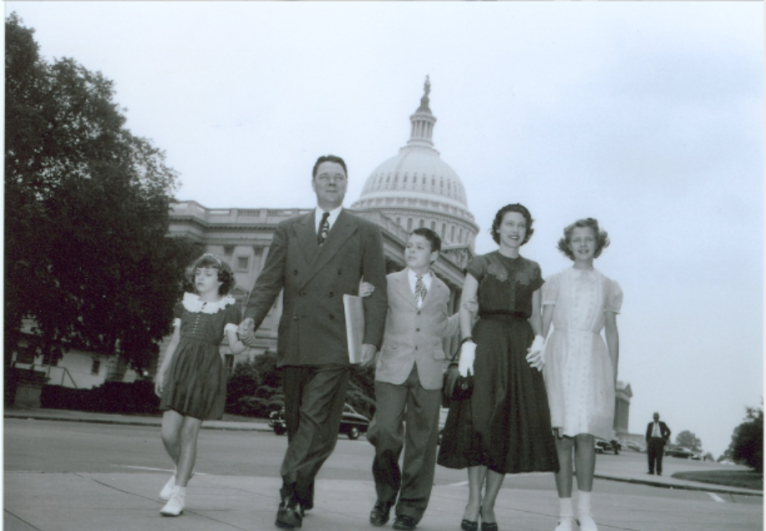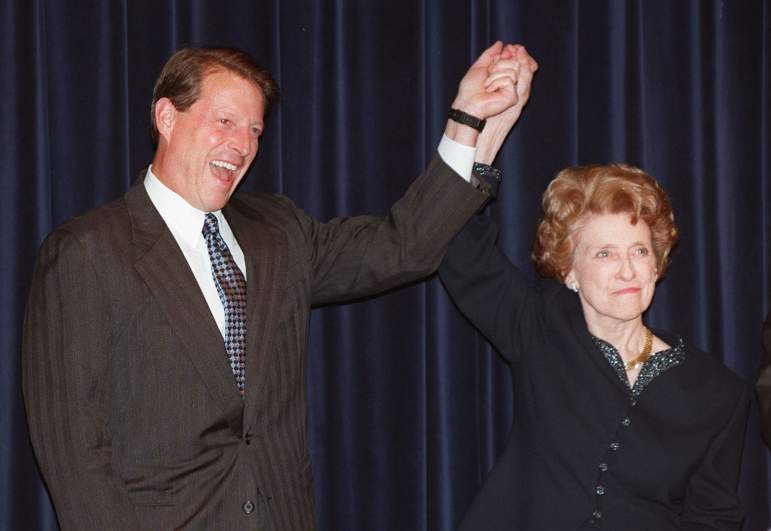
Getty/US House Hale Boggs was the father of Cokie Roberts.
When Hale Boggs, Cokie Roberts’ father, was presumed dead in a mysterious Alaskan plane crash, he was serving as U.S. House Majority Leader and had served on the Warren Commission investigating the assassination of John F. Kennedy.
The plane was never found. No bodies or wreckage ever turned up. One of the most prominent Democratic political leaders in the country had simply vanished into thin air, along with another Congressman, an aide, and the pilot. It’s remained an enduring mystery ever since.
Boggs’ wife, Lindy, buoyed by a state’s grief, replaced him in the U.S. House, becoming a powerful voice all her own and Louisiana’s first woman to serve in Congress. The couple’s daughter, Cokie Roberts, would emerge as one of the country’s top political journalists, largely offering commentary and congressional reporting for ABC News.
Cokie Roberts, who was also an author, has died at the age of 75, according to ABC News. Cokie Roberts received bipartisan tributes after her death, including from both Presidents Barack Obama and George W. Bush. American Women in Radio and Television named Roberts “one of the 50 greatest women in the history of broadcasting,” ABC reported.
Here’s what you need to know about Hale Boggs:
1. Hale Boggs Was a Lawyer Born in Mississippi Who Served in Many Powerful Positions in Congress

The Boggs family in a photo in the Congressional archives. Cokie is pictured on the far left with her parents and siblings.
Hale Boggs’ full name was Thomas Hale Boggs Sr. According to his U.S. House biography, he was born in Long Beach, Mississippi in 1914 and attended both public and religious schools in Jefferson Parish, Louisiana.
Hale Boggs graduated from Tulane University with both his undergraduate and law degrees. He started a law practice in New Orleans and then was elected as a Democrat to Congress in 1941. He served two years and was defeated at the ballot box.
After his initial defeat, Boggs resumed practicing law and then joined the U.S. Naval Reserve during World War II. He “was commissioned an ensign and attached to the Potomac River Naval Command and the United States Maritime Service until separated in January 1946,” the bio reads. At that time, he was elected again to Congress, serving in 13 of them.
His positions in the U.S. House were powerful and many; The House bio says he served as “chairman, Special Committee on Campaign Expenditures (Eighty-second Congress); majority whip (Eighty-seventh through Ninety-first Congresses), majority leader (Ninety-second Congress).”
According to a biography and oral history for Roberts created by the U.S. House, Cokie Roberts was born on December 27, 1943, in New Orleans, Louisiana.
Cokie Roberts was the daughter “of prominent U.S. Representatives Hale Boggs and Lindy Boggs, who represented a New Orleans-centered district for half a century,” a U.S. House biography for her says, adding that “Roberts recalled riding the old Senate subway, with its wicker seats; accompanying her father on the House Floor on the Opening Day of Congress in the late 1940s; prodding her father to speak out on the floor in support of the Voting Rights Act of 1965; and listening to prominent dinner guests such as Speaker Sam Rayburn of Texas.”
2. Cokie’s Congressman Dad, Who Served on the Warren Commission, Was on a Campaign Trip When His Plane Disappeared

Hale Boggs
Politico described the details of the plane crash. Hale Boggs, a Democrat, was in a twin-engine Cessna 310 plane. At the time, he was House Majority Leader. The plane “vanished in foul weather on this day in 1972 while en route between Anchorage and Juneau.” The plane also carried Rep. Nick Begich of Alaska, his aide, and a pilot.
A search and rescue operation was launched. According to Politico, it was “the largest search and rescue operation up to that point in U.S. history.” Politico reports that the bodies and plane were never found, sparking conspiracy theories because Roberts’ dad had served on the Warren Commission charged with investigating the John F. Kennedy assassination. According to Lindy’s House Bio, Hale Boggs won re–election after his death but the House then declared the seat vacant.
A 1972 New York Times article on the search explained, “Planes flying between Anchorage and Juneau usually check in with a Coast Guard station 130 miles southwest of here, but Mr. Boggs’s plane failed to make the radio check. Lieutenant Colonel Earl Ray of the Air Force said the search was not being concentrated north of the Hinchinbrook Island checkpoint because the aircraft’s radio could have failed before it went down.” But the plane was never located.
Boggs’ Congressional bio says he “disappeared while on a campaign flight from Anchorage to Juneau, Alaska, October 16, 1972; served from January 3, 1947, until January 3, 1973, when he was presumed dead pursuant to House Resolution 1, Ninety-third Congress.”
3. Roberts’ Mother Lindy Became a Powerful Voice for Women’s Economic Empowerment in Congress

US Vice President Al Gore (L) holds up the hand of Corinne “Lindy” Boggs at the Old Executive Office Building 12 November in Washington, DC. Boggs was later sworn in by Gore as the new US Ambassador to the Vatican.
Thomas Hale Boggs Sr. and Lindy Boggs had three other children; a oral history of Cokie Roberts says that Cokie’s real name is Mary Martha Corinne Morrison Claiborne Boggs, but her well-known nickname came from her brother, Tommy, because he couldn’t pronounce “Corinne” when he was a kid. Lindy Boggs’ name was also Corinne.
Her husband’s death propelled her into her own political career.
According to Lindy Boggs’ House bio, Lindy was “the first woman ever to represent Louisiana in the House.” Lindy once said, “Almost all women’s issues are economic issues, a stunning idea to those persons who want to hear about ‘Great Women’s Issues’ and expect us to be preoccupied with the ERA or abortion or sexual harassment. The major issues of importance that I’ve worked for are economic ones: equal rights for women in business, banking, and home ownership; the promotion of women in the workplace; better jobs in government contracts; and equal opportunities for higher education, especially in science and medicine. Women vote their pocketbooks…it boils down to that.” Lindy, who died at age 97 in 2013, also served as U.S. Ambassador to the Holy See at the Vatican.
Her House bio says that Lindy Boggs had spent “three decades of serving as her husband’s political confidante, strategist, and surrogate campaigner” and “possessed more political acumen than any conceivable challenger. After winning a special election to succeed her husband, Congresswoman Boggs went on to serve 18 years in the House, becoming an advocate for women’s equality, economic opportunity for minorities, and the preservation of House heritage.”
That biography says that Lindy Boggs was born in Pointe Coupee Roads, Louisiana to a lawyer father and mother who remarried a cotton plantation owner when Lindy’s dad died.
4. Conspiracy Theories Emerged About Hale Boggs’ Disappearance
It was perhaps inevitable due to the positions he held and the fact no body or plane were ever found: Conspiracy theories have popped up about the disappearance of Hale Boggs and the others on the plane that day.
NOLA.com, a prominent newspaper in New Orleans, wrote about an online author’s theories into what happened. Journalist Jonathan Walczak wrote a lengthy post outlining his theories. Most people believe the plane crashed due to inclement weather, according to the newspaper.
However, Walczak also offered some other theories. He raised questions about the marriage, after the plane disappeared, of Begich’s wife to a man Walczak dubbed “a murderer and bomber with mafia ties.” He claimed that man – the now deceased Jerry Max Pasley – told investigators “the plane carrying Hale Boggs and Nick Begich may have been intentionally brought down.”
NOLA.com reported that Hale Boggs had accused the FBI of bugging his phones. You can find Walczak’s work on his website here. The website home page reads, “In 1972, two U.S. congressmen, a political aide, and a pilot vanished on a small plane in Alaska. Despite a search of more than 325,000 square miles, they were never found. Less than 17 months later, a murderer and bomber with mafia ties married the widow of one of the missing congressmen. Two decades later, while incarcerated for murder, he told the F.B.I. that the missing plane was bombed. Was he lying?”
His reporting, called Four Down, can be accessed here.
You can read the FBI files on Thomas Hale Boggs here.
5. Cokie Roberts Recalled How She Would Almost ‘Expect to See My Father’ in the Halls of Congress as a Journalist

GettyCokie Roberts at National Archives Foundation Gala on October 21, 2017 in Washington, DC.
For Cokie Roberts, returning to the halls of Congress as an adult journalist evoked powerful childhood memories.
“I was covering the State of the Union, and I was standing in Statuary Hall, and there was a new shot—a new camera angle that we had never used before—and it was down the center aisle at knee height,” she said in the oral history. “And I had this incredible qualm because it all just came rushing back. That was my earliest memory of the chamber, and there it was at the right height for me to see it. But I still have moments in the Capitol where I will turn a corner, and something will just come rushing back. And I’m 63 years old. And there’ll be times when I’ll turn a corner and sort of half expect to see my father. So it’s a very—a place redolent with memories, to put it mildly.”
In the oral history, Roberts discussed how she was a journalist in the 1980s at the same time her mother was a “leading member of the House.” You can see her oral history page here.
Cokie Roberts died of complications from breast cancer, leaving behind her husband, two children, and multiple grandchildren.
READ NEXT: Ric Ocasek’s Death.